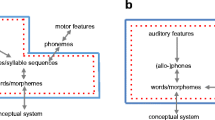Abstract
Many studies have observed phonetic and phonological differences between function words and content words. However, as many of the most commonly cited function words are also very high in frequency, it is unclear whether these differences are the result of syntactic category or word frequency. This study attempts to determine whether syntactically defined function words are indeed phonologically and phonetically reduced or assimilated when word frequency is balanced. Three experiments were designed to distinguish the relative contributions of the factors of category and frequency on phonetic and phonological reduction and assimilation. Overall results suggest that syntactic category and word frequency interact with phonetic and phonological processes in a more complex way than previously believed. Experiment 1 measured final t/d dropping, a reduction process, using electropalatography (EPG). Experiment 2 examined vowel reduction using acoustic measures. In Experiment 3, palatalization, an assimilation process, was examined using EPG. Results showed that t/d dropping responds to the factor of syntactic category, whereas palatalization is affected by word frequency; vowel reduction responded to both factors, with a dominant syntactic category effect and a secondary within-category frequency effect. The implications of these findings for models of lexical representation and theories of language acquisition are discussed.
Similar content being viewed by others
References
D. Bolinger (1975) Aspects of Language Harcourt Brace Jovanovich New York
Bell, A., Jurafsky, D., Fosler-Lussier, E., Girand, C., Gregory, M., Gildea, D. (2001). From variation of English function words in conversation. Unpublished manuscript
J.L. Bybee (2000) The phonology of the lexicon: evidence from lexical diffusion M. Barlow S. Kemmer (Eds) Usage Based Models of Language. CSLI Publications Stanford, CA
D. Byrd C.C. Tan (1996) ArticleTitleSaying consonant clusters quickly Journal of Phonetics. 24 IssueID2 263–282 Occurrence Handle10.1006/jpho.1996.0014
W.E. Cooper J. Paccia-Cooper (1980) Syntax and Speech Harvard University Press Cambridge, MA
Fidelholtz. J. (1975). Word frequency and vowel reduction in English. Papers from the 11th Annual Regional Meeting of the Chicago Linguistic Society, 200–213. CLS, Chicago
B. Gick (2002) ArticleTitleAn X-ray investigation of pharyngeal constriction in American English schwa Phonetica. 59 IssueID1 38–48 Occurrence Handle10.1159/000056204 Occurrence Handle11961420
M. Gregory A. Bell D. Jurafsky W. Raymond (2001) ArticleTitleFrequency and predictability effects on the duration of content words in conversation Journal of the Acoustical Society of America. 110 IssueID5 2738
J.B. Hooper (1976) Word frequency in lexical diffusion and the source of morphophonological change W. Christie (Eds) Current Progress in Historical Linguistics. North Holland Amsterdam 96–105
D. Jurafsky A. Bell M. Gregory W. Raymond (2001) Probabilistic relations between words: Evidence from reduction in lexical production J. Bybee P. Hopper (Eds) Frequency and the Emergence of Linguistic Structure. John Benjamins Amsterdam
E. Kaisse. (1985) Connected Speech Academic Press Orlando
K.K. Kohler. (2000) ArticleTitleThe future of phonetics Journal of the International Phonetic Association. 30 IssueID1/2 1–24
R.W. Langacker (1987) Foundations of Cognitive Grammar, Vol 1: Theoretical Prerequisites Stanford University Press Stanford, CA
L.M. Lavoie (2000) ArticleTitleFunction word reduction: the role of adjacent stress Journal of the Acoustical Society of America. 108 IssueID5 2465
W. Leslau (1969) ArticleTitleFrequency as determinant of linguistic change in the Ethiopian languages Word. 25 180–189
J.J. McCarthy (1993) ArticleTitleA case of surface constraint violation Canadian Journal of linguistics. 38 IssueID2 169–195
J. Morton (1969) ArticleTitleInteraction of information in word recognition Psychological Review. 2 165–178
B.S. Phillips (1980) ArticleTitleOld English an∼on: A new appraisal Journal of English linguistics. 14 20–23
B.S. Phillips (1984) ArticleTitleWord frequency and the actuation of sound change Language. 60 IssueID2 320–342
J.B. Pierrehumbert (2001) Exemplar dynamics: Word frequency, lenition, and contrast J. Bybee P. Hopper (Eds) Frequency and the Emergence of Linguistic Structure. John Benjamins Amsterdam
Selkirk, E. (1972). The phrase phonology of English and French. Ph.D. thesis, MIT
Shi, R. (1995/1996). Perceptual correlates of content words and function words in early language input (Ph.D. dissertation, Brown University). Dissertation Abstracts International, 56, 3108A
R. Shi J.L. Morgan P. Allopenna (1998) ArticleTitlePhonological and acoustic bases for earliest grammatical category assignment: A cross-linguistic perspective Journal of Child Language. 25 169–201 Occurrence Handle10.1017/S0305000997003395 Occurrence Handle9604573
R. Shi J. Werker J. Morgan (1999) ArticleTitleNewborn infants’ sensitivity to perceptual cues to lexical and grammatical words Cognition. 72 B11–21 Occurrence Handle10.1016/S0010-0277(99)00047-5 Occurrence Handle10553673
R. Shi J. Werker (2001) ArticleTitleSix-month-old infants’ preference for lexical words Psychological Science. 12 IssueID1 70–75 Occurrence Handle10.1111/1467-9280.00312 Occurrence Handle11294231
R. Shi J. Werker (2003) ArticleTitleBasis of preference for lexical words in six-month-old infants Developmental Science. 6 IssueID5 484–488 Occurrence Handle10.1111/1467-7687.00305
D.R. Bergen Particlevan (1993) ArticleTitleAcoustic vowel reduction as a function of sentence accent, word stress, and word class Speech communication. 12 IssueID1 1–23 Occurrence Handle10.1016/0167-6393(93)90015-D
Zsiga E.C. (1993/1994). Features, gestures, and the temporal aspects of phonological organization (Ph.D. dissertation, Yale University). Dissertation Abstracts International, 54, 2563A
E.C. Zsiga (1994) ArticleTitleAcoustic evidence for gestural overlap in consonant sequences Journal of Phonetics. 22 IssueID2 121–140
E.C. Zsiga (2000) ArticleTitlePhonetic alignment constraints: consonant overlap and palatalization in English and Russian Journal of Phonetics. 28 IssueID1 69–102 Occurrence Handle10.1006/jpho.2000.0109
A.M. Zwicky (1970) ArticleTitleAuxiliary reduction in English Linguistic Inquiry. 1 323–326
Author information
Authors and Affiliations
Corresponding author
Rights and permissions
About this article
Cite this article
Shi, R., Gick, B., Kanwischer, D. et al. Frequency and Category Factors in the Reduction and Assimilation of Function Words: EPG and Acoustic Measures. J Psycholinguist Res 34, 341–364 (2005). https://doi.org/10.1007/s10936-005-6138-4
Issue Date:
DOI: https://doi.org/10.1007/s10936-005-6138-4




